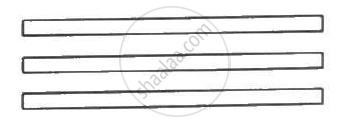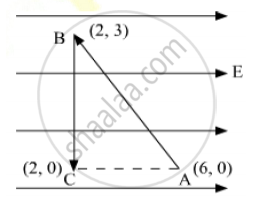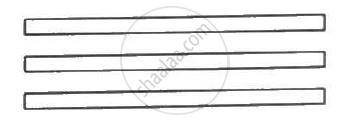Advertisements
Advertisements
प्रश्न
The capacitance between the adjacent plates shown in figure is 50 nF. A charge of 1⋅0 µC is placed on the middle plate. (a) What will be the charge on the outer surface of the upper plate? (b) Find the potential difference developed between the upper and the middle plates.

उत्तर

(a) When the charge of 1 µC is introduced on plate B, the charge gets equally distributed on its surface. All sides of the plate gets 0.5 µC of charge. Due to induction, 0.5 µC charge is induced on the upper surface of plate A.
(b) Given:-
Capacitance, C = 50 nF = `50 xx 10^-9 "F"` = `5 xx 10^-8 "F"`
Effective charge on the capacitor, `Q_"net" = (1 "uC" - 0)/2 = 0.5 "uC"`
∴ Potential difference between plates B and A, `V = Q_"net"/C = (5 xx 10^-7)/(5 xx 10^-8) = 10 V`
APPEARS IN
संबंधित प्रश्न
A metal rod of square cross-sectional area A having length l has current I flowing through it when a potential difference of V volt is applied across its ends (figure I). Now the rod is cut parallel to its length into two identical pieces and joined as shown in figure II. What potential difference must be maintained across the length of 2l. so that the current in the rod is still I?

Explain the principle of a device that can build up high voltages of the order of a few million volts.
A test charge ‘q’ is moved without acceleration from A to C along the path from A to B and then from B to C in electric field E as shown in the figure. (i) Calculate the potential difference between A and C. (ii) At which point (of the two) is the electric potential more and why?

A 100 pF capacitor is charged to a potential difference of 24 V. It is connected to an uncharged capacitor of capacitance 20 pF. What will be the new potential difference across the 100 pF capacitor?
A charge of 1 µC is given to one plate of a parallel-plate capacitor of capacitance 0⋅1 µF and a charge of 2 µC is given to the other plate. Find the potential difference developed between the plates.
The capacitance between the adjacent plates shown in the figure is 50 nF. A charge of 1.0µC is placed on the middle plate. If 1.0 µC is placed on the upper plate instead of the middle, what will be the potential difference between (a) the upper and the middle plates and (b) the middle and the lower plates?

A capacitor having a capacitance of 100 µF is charged to a potential difference of 50 V. (a) What is the magnitude of the charge on each plate? (b) The charging battery is disconnected and a dielectric of dielectric constant 2⋅5 is inserted. Calculate the new potential difference between the plates. (c) What charge would have produced this potential difference in absence of the dielectric slab. (d) Find the charge induced at a surface of the dielectric slab.
The unit of potential difference as used in electrical circuits is ________.
Assertion: Electric potential and electric potential energy are different quantities.
Reason: For a system of positive test charge and point charge electric potential energy = electric potential.
A and B are two points in an electric field. If the work done in carrying 4.0C of electric charge from A to B is 16.0 J, the potential difference between A and B is:
On moving a charge of 20 C by 2 cm, 2 j of work is done then the potential difference between the point is:-
A bullet of mass of 2 g is having a charge of 2 µc. Through what potential difference must it be accelerated, starting from rest, to acquire a speed of 10 m/s.
Can there be a potential difference between two adjacent conductors carrying the same charge?
If potential difference between the two ends of a metallic wire is doubled, drift speed of free electrons in the wire ______.
